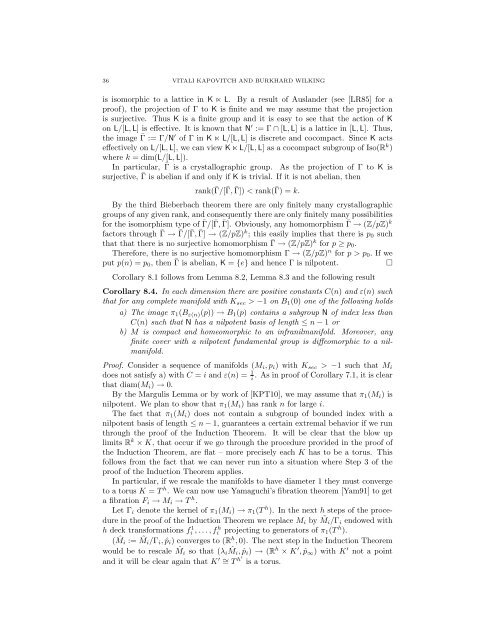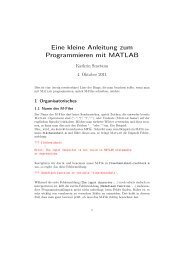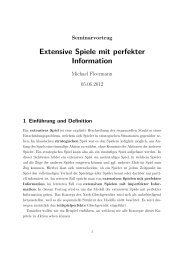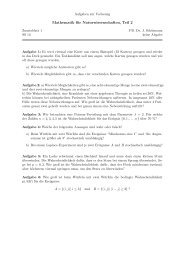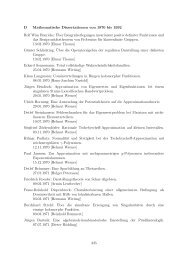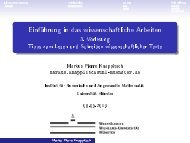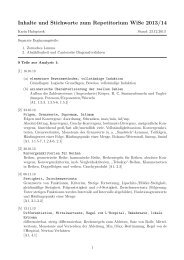Margulis Lemma
Margulis Lemma
Margulis Lemma
You also want an ePaper? Increase the reach of your titles
YUMPU automatically turns print PDFs into web optimized ePapers that Google loves.
36 VITALI KAPOVITCH AND BURKHARD WILKING<br />
is isomorphic to a lattice in K ⋉ L. By a result of Auslander (see [LR85] for a<br />
proof), the projection of Γ to K is finite and we may assume that the projection<br />
is surjective. Thus K is a finite group and it is easy to see that the action of K<br />
on L/[L, L] is effective. It is known that N ′ := Γ ∩ [L, L] is a lattice in [L, L]. Thus,<br />
the image ¯Γ := Γ/N ′ of Γ in K ⋉ L/[L, L] is discrete and cocompact. Since K acts<br />
effectively on L/[L, L], we can view K ⋉ L/[L, L] as a cocompact subgroup of Iso(R k )<br />
where k = dim(L/[L, L]).<br />
In particular, ¯Γ is a crystallographic group. As the projection of Γ to K is<br />
surjective, ¯Γ is abelian if and only if K is trivial. If it is not abelian, then<br />
rank(¯Γ/[¯Γ, ¯Γ]) < rank(¯Γ) = k.<br />
By the third Bieberbach theorem there are only finitely many crystallographic<br />
groups of any given rank, and consequently there are only finitely many possibilities<br />
for the isomorphism type of ¯Γ/[¯Γ, ¯Γ]. Obviously, any homomorphism ¯Γ → (Z/pZ) k<br />
factors through ¯Γ → ¯Γ/[¯Γ, ¯Γ] → (Z/pZ) k ; this easily implies that there is p 0 such<br />
that that there is no surjective homomorphism ¯Γ → (Z/pZ) k for p ≥ p 0 .<br />
Therefore, there is no surjective homomorphism Γ → (Z/pZ) n for p > p 0 . If we<br />
put p(n) = p 0 , then ¯Γ is abelian, K = {e} and hence Γ is nilpotent.<br />
□<br />
Corollary 8.1 follows from <strong>Lemma</strong> 8.2, <strong>Lemma</strong> 8.3 and the following result<br />
Corollary 8.4. In each dimension there are positive constants C(n) and ε(n) such<br />
that for any complete manifold with K sec > −1 on B 1 (0) one of the following holds<br />
a) The image π 1 (B ε(n) (p)) → B 1 (p) contains a subgroup N of index less than<br />
C(n) such that N has a nilpotent basis of length ≤ n − 1 or<br />
b) M is compact and homeomorphic to an infranilmanifold. Moreover, any<br />
finite cover with a nilpotent fundamental group is diffeomorphic to a nilmanifold.<br />
Proof. Consider a sequence of manifolds (M i , p i ) with K sec > −1 such that M i<br />
does not satisfy a) with C = i and ε(n) = 1 i<br />
. As in proof of Corollary 7.1, it is clear<br />
that diam(M i ) → 0.<br />
By the <strong>Margulis</strong> <strong>Lemma</strong> or by work of [KPT10], we may assume that π 1 (M i ) is<br />
nilpotent. We plan to show that π 1 (M i ) has rank n for large i.<br />
The fact that π 1 (M i ) does not contain a subgroup of bounded index with a<br />
nilpotent basis of length ≤ n − 1, guarantees a certain extremal behavior if we run<br />
through the proof of the Induction Theorem. It will be clear that the blow up<br />
limits R k × K, that occur if we go through the procedure provided in the proof of<br />
the Induction Theorem, are flat – more precisely each K has to be a torus. This<br />
follows from the fact that we can never run into a situation where Step 3 of the<br />
proof of the Induction Theorem applies.<br />
In particular, if we rescale the manifolds to have diameter 1 they must converge<br />
to a torus K = T h . We can now use Yamaguchi’s fibration theorem [Yam91] to get<br />
a fibration F i → M i → T h .<br />
Let Γ i denote the kernel of π 1 (M i ) → π 1 (T h ). In the next h steps of the procedure<br />
in the proof of the Induction Theorem we replace M i by ˜M i /Γ i endowed with<br />
h deck transformations fi 1, . . . , f i h projecting to generators of π 1 (T h ).<br />
( ˆM i := ˜M i /Γ i , ˆp i ) converges to (R h , 0). The next step in the Induction Theorem<br />
would be to rescale ˆM i so that (λ i ˆMi , ˆp i ) → (R h × K ′ , ˆp ∞ ) with K ′ not a point<br />
and it will be clear again that K ′ ∼ = T h′ is a torus.


